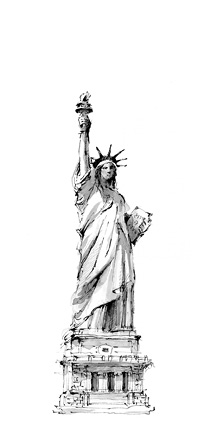CHAPTER 4
A WALK DOWN WALL STREET
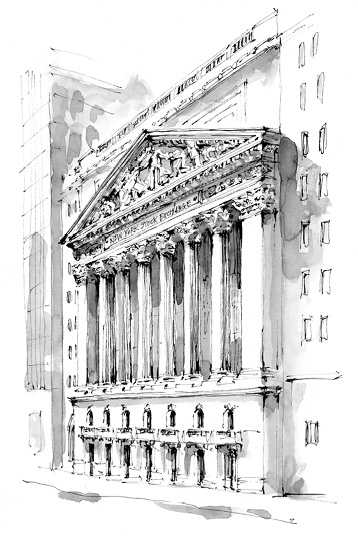
New York Stock Exchange
Wall Street
Start point: Trinity Church
WALL STREET takes it name from the wall erected along the northern border of New Amsterdam, on the orders of Dutch director Peter Stuyvesant, in 1653, to protect the city against an invasion from the north by the British. The street also follows the line of the wall, which was a 9 ft (2.7 m) high wooden palisade that ran from the western shoreline, where Trinity Churchyard is now, to the eastern shoreline at Pearl Street. The defensive capabilities of the wall were never tested as New Amsterdam was given up without a fight, and the British demolished the wall in 1699. Since the establishment of a permanent home for the New York Stock Exchange at the junction of Wall Street and Broad Street in 1865, the term Wall Street has become synonymous with high finance and is often used to refer to the entire financial district of New York.
No. 1 Wall Street
Across Broadway from Trinity Church is NO. 1 Wall Street, global headquarters of THE WORLD’S LARGEST DEPOSIT BANK, THE BANK OF NEW YORK MELLON CORPORATION. The 50-story, 654 ft (199 m) high art deco building was completed in 1931 to be the new headquarters of the Irving Trust Company, who moved here from the Woolworth Building. The pointed windows of No. 1 Wall Street mirror the Gothic design of Trinity Church, while the art deco interior is among the most splendid in New York.
In 1988 the Irving Trust Company was taken over by the Bank of New York.
Bank of New York
The BANK OF NEW YORK was founded in 1784, not long after the departure of British troops from New York, by ALEXANDER HAMILTON and a number of prominent New York businessmen, among them ISAAC ROOSEVELT, great-great grandfather of Franklin D. Roosevelt. They all responded to an advertisement in the New York Packet for “Gentlemen of this City to establish a BANK on liberal principles.” Hamilton was chosen to write the bank’s constitution, and its first headquarters was established in the mansion home on Pearl Street of shipping merchant WILLIAM WALTON.
In 1789, as THE FIRST U.S. TREASURY SECRETARY, Hamilton was able to negotiate the U.S. GOVERNMENT’S FIRST-EVER LOAN. Issued by the Bank of New York, it was for $200,000 and was key to establishing the creditworthiness and economic independence of the new government.
The Bank of New York’s stock was THE FIRST CORPORATE STOCK TRADED ON THE NEW YORK STOCK EXCHANGE when the exchange was formed in 1792, and for the first 15 years of its existence the Bank of New York financed virtually all of New York’s commercial activity. As the industrial age got under way, the bank raised money for the Erie Canal, railroads, and the New York subway system.
In 1988 the bank moved to No. 1 Wall Street and in 2007 it merged with the MELLON FINANCIAL CORPORATION, creating the WORLD’S LARGEST SECURITIES SERVICING PROVIDER.
Now walk east down Wall Street, with your back to Trinity Church, until you reach the junction with Nassau and Broad Streets, and you will find yourself at the very heart of New York’s financial district. Across the road, on the corner with Nassau Street stands the . . .
Federal Hall National Memorial
If any place could be said to be the birthplace of the United States as an independent nation then this place is it, for it was here, on the balcony of the original Federal Hall that stood here until 1812, that GEORGE WASHINGTON was sworn in as THE 1st PRESIDENT of the United States, receiving the presidential oath from New York’s CHANCELLOR ROBERT R. LIVINGSTON. The date was April 30, 1789, and the event is commemorated by a statue of Washington, positioned on the front steps of the present hall at the actual point where the president would have been standing on the balcony of the old hall. The statue was sculpted by JOHN QUINCY ADAMS WARD and was unveiled in 1883.

The first Federal Hall was built here in 1699 to replace the Stadt Huys on Pearl Street as New York’s City Hall. In 1735 the publisher John Peter Zenger was imprisoned and tried in the hall, while in October 1765 the STAMP ACT CONGRESS, attended by delegates from nine of the original 13 states, met there to protest about “taxation without representation.”
After the Revolution, in 1788, City Hall was enlarged and remodeled by PIERRE L’ENFANT (who would go on to design Washington, D.C.) to serve as THE FIRST CAPITOL OF THE UNITED STATES. It was renamed Federal Hall, and on March 4, 1789, the 1st U.S. Congress met there to form the new federal government and count the votes that saw George Washington elected as U.S. president. On September 25, 1789, the United States BILL OF RIGHTS was adopted at Federal Hall by the 1st Congress, cementing the freedoms and rights that had been demanded by the Stamp Act Congress in that same hall 24 years before.
In 1790 the federal government transferred to Philadelphia, and Federal Hall became City Hall once more. In 1812 the building was pulled down and New York’s government moved north up Broadway to a new City Hall on the Commons.
The grand Greek Revival building that stands here today was put up in 1842 as the New York Customs House and was later used as a Sub Treasury, where the country’s gold and silver bullion was stored. The bullion was moved to the Federal Reserve in Liberty Street in 1920, and the building is now operated by the National Parks Services and serves as a tourism center and museum.
Morgan Bank
Directly across Wall Street on the corner with Broad Street, at No. 23, is the former home of MORGAN’S BANK. JOHN PIERPONT MORGAN (1837–1913) was a businessman, railroad magnate, and the dominant banker of his generation. He organized the formation of a number of huge industrial conglomerates such as General Electric, AT&T, and the United States Steel Corporation and was so successful at restructuring failing businesses that the process became known as “Morganization.” In 1907 Morgan was asked by the government to intervene in a banking crisis, which was averted when he contributed money from his own bank to a rescue fund and persuaded other Wall Street bankers to do the same, locking them into the magnificent library at his home on 36th Street, until they agreed to pay up.
The Morgan Library
J. P. Morgan’s library, on East 36th Street off Madison Avenue, contains one of the finest collections of rare books and manuscripts in the world and was opened to the public in 1924. It is housed in a palazzo-style building erected in 1902, with an annex added in 1928. In 1988 the 19th-century brownstone house where J. P. Morgan Jr. lived was incorporated into the library complex via a garden courtyard. Highlights of the collection include a Gutenberg Bible printed in 1455, the world’s largest collection of Robert Burns’s letters, scraps of paper on which Bob Dylan had scribbled the lyrics to “Blowin’ in the Wind,” original drawings by William Blake, and an autographed manuscript of Charles Dickens’s A Christmas Carol.
The Morgan Bank moved to this corner of Wall Street in 1873, and at the end of the 20th century decided to build a new headquarters on the site. To ensure that there would be enough marble for their new building the bank bought an entire marble quarry in Tennessee. J. P. Morgan himself never got to see his new headquarters, for he died just before the building was completed in 1913. He was succeeded by his son J. P. Morgan Jr.
While all the other banks and financial institutions of Wall Street were throwing up showy skyscrapers to boost their image, the House of Morgan was secure enough in its wealth and reputation to require just four stories for its new head office, while the name of Morgan was so famous that it was deemed unnecessary to fix a nameplate by the door.
In 1920 an anarchist bomb exploded in the street outside, killing 30 people and spraying the bank with debris. It was assumed that J. P. Morgan Jr. was the target, and as a reminder of the outrage the pockmarks on the wall of the bank have never been repaired. Morgan’s Bank eventually merged and vacated No. 23 Wall Street in 2000. The building is now offices.

New York Stock Exchange
The NEW YORK STOCK EXCHANGE (NYSE) was formed in May 1792 by a small group of traders who met daily in the shade of a buttonwood (sycamore) tree growing outside their offices at No. 68 Wall Street. Later that year they all signed up to what became known as the BUTTONWOOD AGREEMENT, and their tiny, informal organization grew into THE LARGEST STOCK EXCHANGE IN THE WORLD. Today, a small sycamore tree stands outside the NYSE in memory of the buttonwood tree beneath which the exchange was founded.
One of the first rules the early traders made was that they would only trade with each other, and until 2006 you could still only trade on the NYSE if you were a member. Membership was limited to 1,366, and in good years seats sometimes changed hands for upward of $4 million. In 2006 the NYSE became a for-profit, publicly traded company, and traders now purchase licenses for one year.
For the first years of its existence the stock exchange had no permanent home of its own and would most usually meet at TONTINE’S COFFEE HOUSE on the corner of Wall Street and Water Street. The exchange moved to its present site on Broad Street in 1865, but by the turn of the century business had increased so much that more space was needed, so in 1901 the old exchange building was knocked down and the present, grand neoclassical building opened for business in 1903.
The square in front of the stock exchange has seen many crowd gatherings in times of financial turmoil, most famously during the Great Wall Street Crash of October 1929, which ushered in the Great Depression, when anxious investors massed outside the exchange waiting for news of their stocks and shares.
After 9/11 a huge American flag was draped across the Broad Street Colonnade, and in 2011 the stock exchange was the focus of Occupy Wall Street demonstrations.
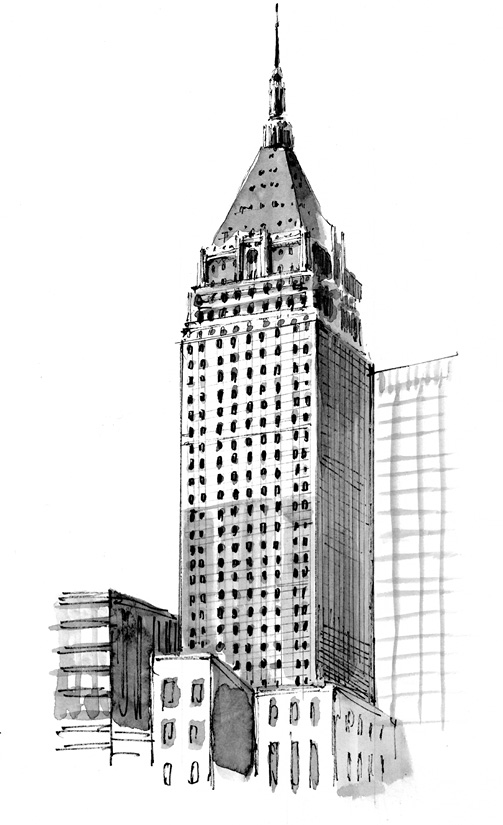
No. 40 Wall Street
Continue east on Wall Street until you come to No. 40 on your left. Now the TRUMP TOWER, this was originally the BANK OF MANHATTAN TRUST BUILDING, and THE TALLEST BUILDING IN THE WORLD—briefly. It took only 11 months to build, largely because it was involved in a race with the Chrysler Building to be the tallest in the world. When completed in 1930 the Bank of Manhattan Trust Building was 927 ft (283 m) high, 136 ft (41 m) higher than the previous tallest building in the world, the Woolworth Building. More importantly, it was 2 ft (0.6 m) higher than the Chrysler Building, which was about to be topped off at 925 ft (282 m). Walter Chrysler, however, had hatched a dastardly plan, and as soon as the Manhattan bankers were congratulating themselves on owning the tallest building in the world, Chrysler hoisted into place a previously concealed 125 ft (38 m) high stainless steel spire, which gave the Chrysler Building an overall height of 1,046 ft (319 m). Shreve and Lamb, the architects of No. 40 Wall Street, cried foul, claiming that their building was morally the tallest because the Chrysler spire was purely ornamental while their Manhattan Building had THE HIGHEST USABLE FLOOR IN THE WORLD, the Observation Deck, which was at least 100 ft (30 m) higher than the Chrysler Building’s highest usable floor. It made no difference. No. 40 Wall Street had been the tallest building in the world for less than a month.
Perhaps, then, there was a certain justice when the Chrysler Building itself was overtaken less than a year later by the Empire State Building.
Nos. 48–95 Wall Street
Continue east on Wall Street. At No. 48 is the MUSEUM OF AMERICAN FINANCE, occupying what was once the banking hall of the Bank of New York Building of 1928. This was the former site of the Bank of New York’s first purpose-built head office, constructed in 1797.
No. 52 is where the CITY BANK OF NEW YORK, now Citibank, was founded in 1812. On March 20, 1831, No. 52 became the scene of THE FIRST BANK ROBBERY IN U.S. HISTORY, when a villain called EDWARD SMITH robbed the City Bank of $245,000. He was soon caught and sentenced to five years in Sing Sing prison.
No. 58 is where Alexander Hamilton lived from 1783 to 1790, while working on the Bank of New York.
No. 68 is close to the site of the original buttonwood tree under which the founders of the NYSE gathered, while the Tontine Coffee House, where they later met, stood farther down on the corner of Water Street at No. 82.
Diagonally across Water Street at No. 95 is the site of the MERCHANT’S COFFEE HOUSE where, in 1784, the Bank of New York was brought into being, over coffee, by Alexander Hamilton and a group of businessmen.
Not Quite There
Now walk north up Water Street, which was the location of NEW YORK’S SLAVE MARKET until 1762, turn left down narrow Pine Street, cross Pearl Street, and on your right is No. 70, the AMERICAN INTERNATIONAL BUILDING (AIB), built by the oil baron Henry Doherty. The AIB building was one of the competitors in the 1930 race to be tallest in the world, and at 952 ft (290 m) high it did beat the Bank of Manhattan Building by 55 ft (17 m) when it was completed in 1932, to become THE TALLEST BUILDING IN LOWER MANHATTAN. The race to be tallest in the world had already been lost by then, first to the Chrysler Building and then to the Empire State Building.
For 75 years though, the AIB could proudly claim to be THE TALLEST BUILDING IN NEW YORK NOT TO HAVE BEEN THE TALLEST BUILDING IN THE WORLD. Alas, even that consolation was taken away in 2007 by the New York Times Building, which in turn was robbed of the title in 2012 by the Freedom Tower.
Note the 12 ft (3.6 m) high scale model of the building over the entrance, carved in stone and complete with its own scale model of the scale model.
Federal Reserve
Continue west on Pine Street, go right on to William Street, walk north, and then turn left onto Liberty Street. The whole block on the right-hand side of the street is occupied by the NEW YORK FEDERAL RESERVE BANK, which contains THE LARGEST HOARD OF GOLD IN THE WORLD, held in THE DEEPEST VAULTS IN NEW YORK, 80 ft (24 m) below street level.
Now continue west along Liberty Street and return to Broadway.
Well, I never 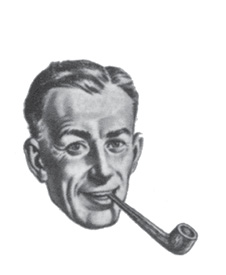 knew this
knew this
about
WALL STREET
ALEXANDER HAMILTON (1755–1804), founder of the Bank of New York, was THE ONLY NEW YORKER TO SIGN THE AMERICAN CONSTITUTION. He co- founded the NATIONAL BANK, the U.S. MINT, and the U.S. COASTGUARD (as the Revenue Marine), and wrote JAY’S TREATY, with which the new U.S. chief justice John Jay negotiated favorable trade terms with Britain. In 1801 he founded the NEW-YORK EVENING POST, which is now AMERICA’S OLDEST CONTINUOUSLY PUBLISHED DAILY NEWSPAPER. For such a distinguished Founding Father, Alexander Hamilton came to a surprisingly sticky end.
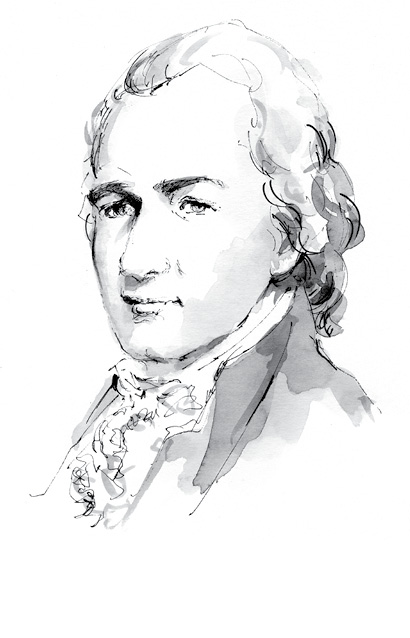
As an opponent, both politically and personally, of his fellow New York politician Aaron Burr, Hamilton frustrated Burr’s candidacy for the U.S. presidency in 1800 and for the governorship of New York in 1804. Finally, in July of 1804, Burr could take no more and challenged Hamilton to a duel, after Hamilton had been overheard making some derogatory remarks about Burr at a dinner party, remarks that were later published in the newspapers. Hamilton refused to apologize, and they met for a duel in Weehawken, New Jersey, on the morning of July 11, 1804 (dueling was illegal in New York). Hamilton was shot in the stomach and died the next day. He was given a hero’s burial, with thousands lining his funeral procession along Broadway to Trinity Church, where he is buried.
AARON BURR (1756–1836), meanwhile, despite a distinguished career as a senator for New York and as vice president to Thomas Jefferson, will always be remembered for murdering Alexander Hamilton. Jefferson dropped him as his vice president for the election in 1804, and Burr’s political career was finished. He returned to practice law in New York and lived out the rest of his long life in obscurity, dying on Staten Island in 1836 at the age of 80.
ROBERT R. LIVINGSTON (1746–1813), who administered the oath to George Washington in Federal Hall, went on to become THE FIRST U.S. SECRETARY OF FOREIGN AFFAIRS, a position that evolved into secretary of state. He was later appointed as U.S. MINISTER TO FRANCE during which time he negotiated the LOUISIANA PURCHASE, which more than doubled the size of the United States. The territory gained stretched from the Mississippi to the Rocky Mountains and worked out at roughly 42 cents an acre ($1 a hectare).
On the wall of the Federal Hall in Nassau Street there is a bronze map of Ohio, which commemorates the OHIO COMPANY, a group of Revolutionary army officers who got together in 1786 to plan and organize the settlement of territory northwest of the Ohio River. In 1787 they met with Congress at Federal Hall to discuss the purchase of the land, and in July that year Congress passed the NORTHWEST ORDNANCE, creating the Northwest Territory, which would become the states of Ohio, Indiana, Illinois, Michigan, and Wisconsin.
The highlight of the museum in the Federal Hall National Memorial is the GEORGE WASHINGTON INAUGURAL BIBLE. Printed in London in 1625, the Bible was loaned to Washington for his inauguration by a local New York Masonic Lodge and has since been used at the inaugurations of Presidents Warren G. Harding, Dwight D. Eisenhower, Jimmy Carter, and most recently George H. W. Bush, whose inauguration in 1989 took place exactly 200 years after Washington’s.
THE FIRST RECORDED PLAY IN NEW YORK, as reported in the New England and Boston Gazette of January 1, 1733, was a performance of George Farquhar’s The Recruiting Officer at the “New Theater” on Nassau Street, on December 11, 1732. The New Theater was a converted warehouse belonging to the acting governor of the colony RIP VAN DAM. There is some suggestion that a rival theater was set up in a back room of ABRAHAM CORBETT’S TAVERN on Broadway at Beaver Street, near the governor’s quarters, by WILLIAM COSBY, who succeeded Van Dam as governor. The two disliked each other intensely.
The Bank of the Manhattan Company, which opened its first office at No. 40 Wall Street in 1799, was founded by Aaron Burr as a rival to Alexander Hamilton’s Bank of New York.
In 1946 a U.S. Army Air Force plane crashed into the 58th floor of No. 40 Wall Street, the Bank of Manhattan Trust Building, in thick fog, killing all five people on board. No one in the building, or on the street below, was injured.
